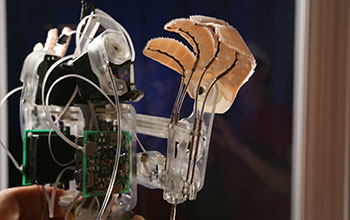Multimedia Gallery
Climbing Robot "Stickybot" (Image 5)
Close up view looking at top side detail of Stickybot, a robot whose feet are covered with gecko-inspired, directional-adhesive material that allows it to climb smooth surfaces. [Image 5 of 8 related images. See Image 6.]
More about this Image
Stickybot was developed by Sangbae Kim (a graduate student at Stanford University at the time; now an assistant professor of mechanical engineering at MIT) and Stanford professor Mark Cutkosky and colleagues.
After researchers discovered in 2006 that geckos use a phenomenon called directional adhesion to stick to walls, Kim realized that "stickiness does not necessarily come from chemical composition; it can come from mechanical properties and geometry." "The geometry enables strange phenomena such as directional adhesion, which sticks in only one direction," says Kim.
Kim--who says he often looks to the animal kingdom for inspiration in robot design--developed the adhesive material to mimic the pads on a gecko's feet, which are covered with a forest of tiny hairs called setae (some of which are one-twentieth the width of a human hair). The setae, in turn, branch into hundreds of tiny smaller hairs called spatula, that are about one-thousandth the width of a human hair. The hairs cling to surfaces using tiny molecular interactions known as van der Waals forces.
Kim's adhesive material is covered with hairs made of rubber silicone, that are thicker than those on a gecko's paw and about four times thicker than a human hair. Thicker hairs require smoother surfaces for adhesion, so Stickybot can only climb extremely smooth surfaces like glass.
Possible applications for Stickybot technology include exterior repair of underwater oil pipelines and window washing. Kim has plans to design climbing equipment for humans using the directional adhesion technology as well.
Kim is now designing a running robot that mimics the movements of a cheetah. An agile, fast-moving robot such as this could perform military surveillance and search-and-rescue missions that are too dangerous for humans. To learn more about Kim's robotics research, visit the Biomimetric Robotics Lab at MIT, Here. [Research on the dry adhesive used by Stickybot for climbing was funded in part by a grant from the National Science Foundation (07-08367).] (Date of Image: 2008)
Credit: Mark R. Cutkosky, Stanford University; Sangbae Kim, MIT
Images and other media in the National Science Foundation Multimedia Gallery are available for use in print and electronic material by NSF employees, members of the media, university staff, teachers and the general public. All media in the gallery are intended for personal, educational and nonprofit/non-commercial use only.
Images credited to the National Science Foundation, a federal agency, are in the public domain. The images were created by employees of the United States Government as part of their official duties or prepared by contractors as "works for hire" for NSF. You may freely use NSF-credited images and, at your discretion, credit NSF with a "Courtesy: National Science Foundation" notation.
Additional information about general usage can be found in Conditions.
Also Available:
Download the high-resolution JPG version of the image. (4.9 MB)
Use your mouse to right-click (Mac users may need to Ctrl-click) the link above and choose the option that will save the file or target to your computer.



